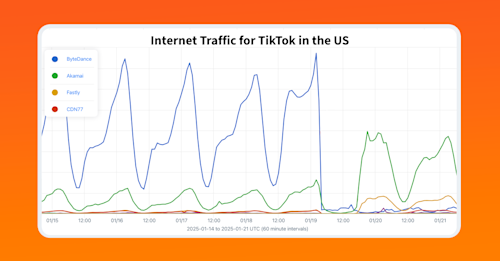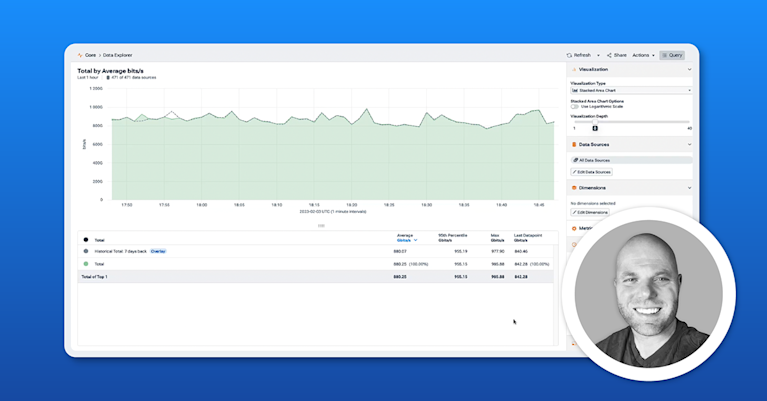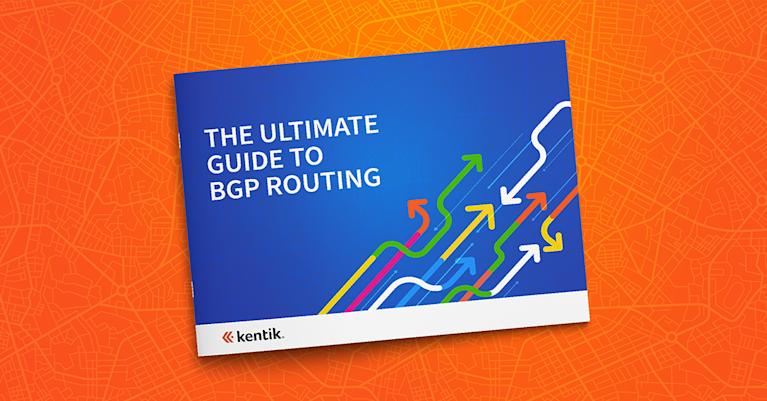TikTok Emerges from Shutdown Without Bytedance’s US CDN


Summary
Kentik’s Doug Madory looks into this weekend’s 14-hour outage of popular video sharing service TikTok, which was slated to be banned from the US per recent legislation. While TikTok came back, it is notably no longer being served by parent company Bytedance’s US CDN. We delve into the traffic statistics in this blog post.
On Saturday evening, TikTok ceased operating in the United States as a law banning the service went into effect. However, 14 hours later, the popular app, used by 170 million users in the US, resumed service — but notably without the support of parent company Bytedance’s US CDN.
Background
The Chinese-owned video sharing service became a political target in recent years, beginning with President Trump’s call to ban the service in the final months of his first administration. Despite TikTok signing a deal to store US data with US database and cloud computing company Oracle, TikTok’s purported links to the Chinese government led Congress to pass a law banning it from the United States if it wasn’t sold to a US company.
On Thursday, the Biden administration announced that it would not enforce the ban, essentially leaving it up to the incoming Trump administration to handle. And on Friday, the US Supreme Court voted unanimously to uphold the ban set to take effect on Sunday, January 19 — awkwardly, one day before President Trump was to take office.
In the waning hours of Saturday, January 18, TikTok went dark.
The outage
TikTok is one of hundreds of services analyzed by Kentik’s OTT Service Tracking. Whether it’s Netflix’s Mike Tyson fightor Microsoft’s Patch Tuesday, this unique functionality gives users the ability to explore many dimensions of how traffic for a particular service is sourced and delivered.
Based on our aggregate NetFlow data from our OTT Service Tracking customers, we observed traffic for TikTok ceased at 03:30 UTC on Sunday, January 19 (or 10:30pm ET on Saturday, January 18). The dropoff in traffic, broken down by source CDN, is depicted below:

The return
Only 14 hours after TikTok went down, the company announced that it was in the process of restoring service, thanking the incoming president for “providing the necessary clarity and assurance to our service providers that they will face no penalties providing TikTok.”
At 17:30 UTC (12:30pm ET), users began reporting that they were able to access the service again, and we started seeing TikTok traffic begin to flow — only now with a change to the composition of traffic sources: no traffic from Bytedance’s US CDN.
The graph below shows TikTok traffic to the US over the past week by source CDN. Prior to the outage, Bytedance’s US CDN (blue line) was clearly the largest source of TikTok traffic in bits/sec. After the outage, it was delivering none, with Akamai (green), Fastly (orange) and CDN77 (red) taking up the slack.

And we weren’t the only ones to notice that Bytedance’s US CDN is no longer sending traffic. Below is a broader view at the dropoff in traffic from AS396986 to the US in the past week — each line represents a different US provider (unique destination AS).

Conclusion
At the time of this writing, if you search for TikTok on the Apple App Store in the US, you get a message that reads, ”TikTok and other ByteDance apps are not available in the country or region you’re in.” So, the future of TikTok is still very much up in the air in the US.
Like the App Store message, the loss of ByteDance’s US CDN as a source of TikTok traffic may simply be another measure of precaution taken by TikTok to avoid incurring the penalties from the ban.
Several TikTok users have reported that the service behaves differently following the restoration. While it is hard to empirically measure the behavior of its algorithm, it is definitely the case that the service is hosted differently.


